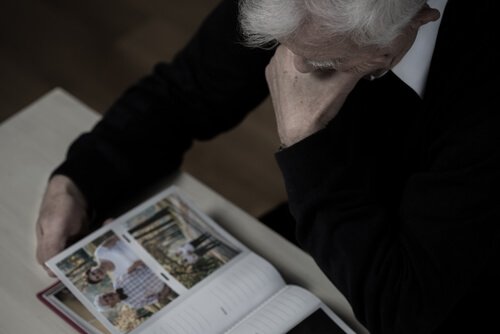Non-Pharmacological Therapy for Dementia

Before defining what Alzheimer’s disease and non-pharmacological therapy consist of, we must first take a look at dementia. Merriam-Webster’s dictionary defines dementia as “a usually progressive condition (such as Alzheimer’s disease) marked by the development of multiple cognitive deficits (such as memory impairment, aphasia, and the inability to plan and initiate complex behavior)”.
Narrowing down the definition, we could say that dementia has different causes and usually involves memory, communication, and attention deterioration. Furthermore, it’s usually chronic and leads to a gradual loss of autonomy and quality of life.
Taking into account this definition, we can define Alzheimer’s disease as a neurodegenerative disease characterized by the presence of cognitive and behavioral impairment. Likewise, it tends to have a gradual onset and progressively gets worse. It usually occurs in adulthood, mainly in older people.
Currently, there isn’t an effective treatment to reverse or permanently stop the course of this disease. However, professionals have developed different types of intervention that help slow down the progress of dementia.
A great example is non-pharmacological therapies that consist of alternative interventions that can improve a patient’s quality of life.

Non-pharmacological therapy has many benefits:
- Maintains and/or stimulates the remaining capacities.
- Promotes the patient’s autonomy and independence.
- Improves social relationships.
- Improves self-image and, therefore, self-esteem.
- Empowers the patient who’s suffering from dementia.
- Improves the quality of life of the patient and the people close to them.
Daily Life Activities
During non-pharmacological therapy, a professional evaluates the performance of the patient with dementia.
The assessment varies depending on the patient’s level of dependence and need for support. The ultimate goal of this therapy is to delay or decrease the deterioration of performance in daily life activities.
Music Therapy
According to the World Federation of Music Therapy, music therapy “is the professional use of music and its elements as an intervention in medical, educational, and everyday environments with individuals, groups, families, or communities who seek to optimize their quality of life and improve their physical, social, communicative, emotional, intellectual, and spiritual health and wellbeing”.
Music therapy can be one non-pharmacological therapy of many others. For example, you could also include dance therapy and physiotherapy and incorporate all of these disciplines into joint sessions. You must always keep each patient’s capacity in mind.
Laughter Therapy
Laughter therapy techniques are based on the theories that laughter is a form of emotional discharge and the incongruity theory of humor. It hopes to trigger spontaneous and genuine laughter in the patient. However, this method oftentimes achieves false or simulated laughter.
Through this non-pharmacological therapy, the patient practices body expression, play, dance, and breathing. All of these help to relieve stress that the disease may generate.
Snoezelen Room
Anne Jean Ayres developed this type of sensory stimulation therapy. Its main objective is for the patient to relax through their senses and by interacting with the people around them.
A Snoezelen room is a soothing and stimulating environment that produces a great sense of well-being in people.
Reminiscence Therapy
It’s a non-pharmacological therapy that’s becoming increasingly popular and works on the patient‘s episodic and autobiographical memory.
Therapists should use resources such as photographs, music, news articles, videos, etc. In particular, these resources allow the person to remember very specific moments in their life. Thus, they’ll be able to ‘relive’ emotional aspects of their memory, such as smells, feelings, and sounds.

Reality Orientation Therapy
The main objective of this therapy is for the patient to become more aware of their reality. Therefore, the therapist will orient them in three areas:
- Weather (date and time).
- Space (where they are).
- Personal awareness (who they are).
This will give the patient a greater understanding of what’s happening. Consequently, it’s a very useful tool when it comes to maintaining the perception of control.
Assisted Intervention with Dogs
Therapy with dogs has great benefits at an emotional, social, functional, and cognitive level. Furthermore, it improves mood, physical and psychological health, and psychomotricity, among other things.
Occupational Therapy
Occupational therapy or ergotherapy seeks to rehabilitate cognitive, physical, and social skills. For this purpose, patients occupy their time in different activities, such as craft making.
Cognitive Stimulation/Training or Rehabilitation
Although similar, each one has a different goal:
- Cognitive rehabilitation encompasses activities that aim to restore damaged cognitive functions. This damage can be due to different causes. For example, skull trauma, mild cognitive impairment, depression, among others.
- On the other hand, cognitive stimulation is the process by which activities are carried out to delay cognitive decline. For instance, when a person notices that they’re beginning to lose their memory.
- Lastly, cognitive training is a set of activities that try to optimize or maintain cognitive performance. It’s a good method to prevent more cognitive impairment and to improve cognitive reserve.

You must take into account that qualified professionals are the only ones who should carry out non-pharmacological therapy and that they should evaluate each case beforehand.
Additionally, we should emphasize that none of these therapies can cure dementia. However, you can achieve significant improvements through non-pharmacological therapy.
Before defining what Alzheimer’s disease and non-pharmacological therapy consist of, we must first take a look at dementia. Merriam-Webster’s dictionary defines dementia as “a usually progressive condition (such as Alzheimer’s disease) marked by the development of multiple cognitive deficits (such as memory impairment, aphasia, and the inability to plan and initiate complex behavior)”.
Narrowing down the definition, we could say that dementia has different causes and usually involves memory, communication, and attention deterioration. Furthermore, it’s usually chronic and leads to a gradual loss of autonomy and quality of life.
Taking into account this definition, we can define Alzheimer’s disease as a neurodegenerative disease characterized by the presence of cognitive and behavioral impairment. Likewise, it tends to have a gradual onset and progressively gets worse. It usually occurs in adulthood, mainly in older people.
Currently, there isn’t an effective treatment to reverse or permanently stop the course of this disease. However, professionals have developed different types of intervention that help slow down the progress of dementia.
A great example is non-pharmacological therapies that consist of alternative interventions that can improve a patient’s quality of life.

Non-pharmacological therapy has many benefits:
- Maintains and/or stimulates the remaining capacities.
- Promotes the patient’s autonomy and independence.
- Improves social relationships.
- Improves self-image and, therefore, self-esteem.
- Empowers the patient who’s suffering from dementia.
- Improves the quality of life of the patient and the people close to them.
Daily Life Activities
During non-pharmacological therapy, a professional evaluates the performance of the patient with dementia.
The assessment varies depending on the patient’s level of dependence and need for support. The ultimate goal of this therapy is to delay or decrease the deterioration of performance in daily life activities.
Music Therapy
According to the World Federation of Music Therapy, music therapy “is the professional use of music and its elements as an intervention in medical, educational, and everyday environments with individuals, groups, families, or communities who seek to optimize their quality of life and improve their physical, social, communicative, emotional, intellectual, and spiritual health and wellbeing”.
Music therapy can be one non-pharmacological therapy of many others. For example, you could also include dance therapy and physiotherapy and incorporate all of these disciplines into joint sessions. You must always keep each patient’s capacity in mind.
Laughter Therapy
Laughter therapy techniques are based on the theories that laughter is a form of emotional discharge and the incongruity theory of humor. It hopes to trigger spontaneous and genuine laughter in the patient. However, this method oftentimes achieves false or simulated laughter.
Through this non-pharmacological therapy, the patient practices body expression, play, dance, and breathing. All of these help to relieve stress that the disease may generate.
Snoezelen Room
Anne Jean Ayres developed this type of sensory stimulation therapy. Its main objective is for the patient to relax through their senses and by interacting with the people around them.
A Snoezelen room is a soothing and stimulating environment that produces a great sense of well-being in people.
Reminiscence Therapy
It’s a non-pharmacological therapy that’s becoming increasingly popular and works on the patient‘s episodic and autobiographical memory.
Therapists should use resources such as photographs, music, news articles, videos, etc. In particular, these resources allow the person to remember very specific moments in their life. Thus, they’ll be able to ‘relive’ emotional aspects of their memory, such as smells, feelings, and sounds.

Reality Orientation Therapy
The main objective of this therapy is for the patient to become more aware of their reality. Therefore, the therapist will orient them in three areas:
- Weather (date and time).
- Space (where they are).
- Personal awareness (who they are).
This will give the patient a greater understanding of what’s happening. Consequently, it’s a very useful tool when it comes to maintaining the perception of control.
Assisted Intervention with Dogs
Therapy with dogs has great benefits at an emotional, social, functional, and cognitive level. Furthermore, it improves mood, physical and psychological health, and psychomotricity, among other things.
Occupational Therapy
Occupational therapy or ergotherapy seeks to rehabilitate cognitive, physical, and social skills. For this purpose, patients occupy their time in different activities, such as craft making.
Cognitive Stimulation/Training or Rehabilitation
Although similar, each one has a different goal:
- Cognitive rehabilitation encompasses activities that aim to restore damaged cognitive functions. This damage can be due to different causes. For example, skull trauma, mild cognitive impairment, depression, among others.
- On the other hand, cognitive stimulation is the process by which activities are carried out to delay cognitive decline. For instance, when a person notices that they’re beginning to lose their memory.
- Lastly, cognitive training is a set of activities that try to optimize or maintain cognitive performance. It’s a good method to prevent more cognitive impairment and to improve cognitive reserve.

You must take into account that qualified professionals are the only ones who should carry out non-pharmacological therapy and that they should evaluate each case beforehand.
Additionally, we should emphasize that none of these therapies can cure dementia. However, you can achieve significant improvements through non-pharmacological therapy.
All cited sources were thoroughly reviewed by our team to ensure their quality, reliability, currency, and validity. The bibliography of this article was considered reliable and of academic or scientific accuracy.
- Tipos de Terapia no farmacológica. Recuperado el 21 de de Febrero 2019 de http://www.crealzheimer.es/
- Valls-Predet, C., Molinuevo, J L. y Rami, L. (2010). Diagnóstico precoz de la enfermedad de Alzheimer: fase prodrómica y preclínica. Revista Neurol 51, 471-80.
- World Federarion of Music Therapy. Recuerado el 21 de Febrero de 2019 de https://www.wfmt.info/wfmt-new-home/about-wfmt/
This text is provided for informational purposes only and does not replace consultation with a professional. If in doubt, consult your specialist.







